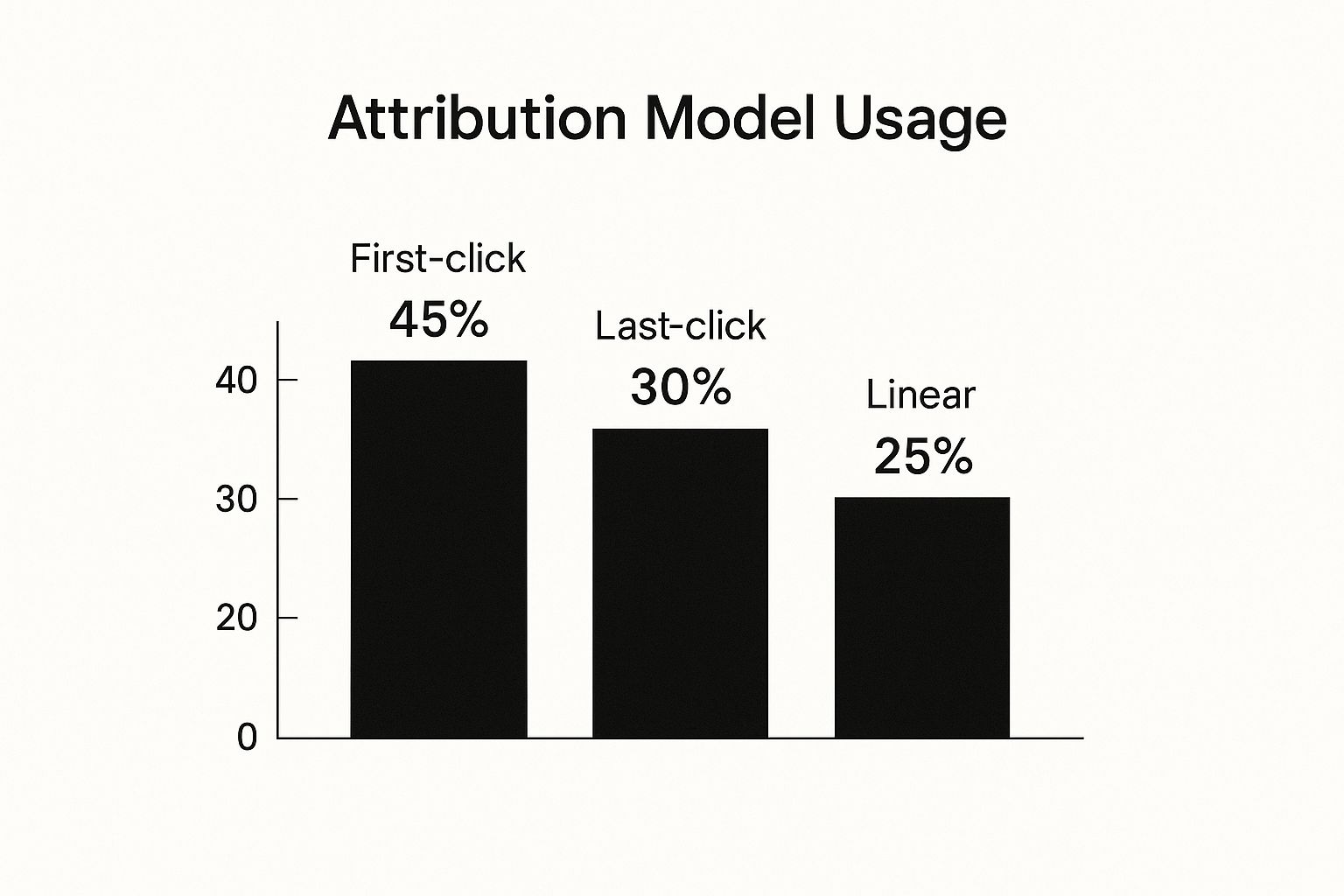Discover what is marketing attribution and transform your marketing ROI. Learn proven models, strategies, and tools to track customer journeys effectively.
What Is Marketing Attribution? Your Complete Success Guide
Understanding What Marketing Attribution Really Means
Let's clarify what marketing attribution means. It's the process of identifying which marketing activities contribute to desired outcomes, such as leads and sales. Essentially, it's about understanding how each touchpoint, from a social media post to a sales email, influences a customer's decision to buy. This goes beyond simply tracking clicks; it's about seeing the bigger picture of the customer journey.
Imagine a customer first finds your brand through a Google ad. Then, they visit your website, download a resource, attend a webinar, and finally make a purchase. Marketing attribution helps determine how much each of these touchpoints contributed to the final sale, crucial for optimizing your marketing strategy and maximizing ROI.
Beyond Clicks: The Evolution of Attribution
Understanding marketing influence isn't new. Marketing attribution dates back to the 1950s with Marketing Mix Models (MMMs). These models analyzed how product, price, place, and promotion impacted consumer behavior. By the 1980s, large corporations widely adopted MMMs to optimize their marketing budgets. The rise of digital marketing in the late 1990s and early 2000s brought new attribution models for online channels. Discover more insights about the history of marketing measurement
Why Customer Journey Mapping Is Essential
Understanding the customer journey is key to effective marketing attribution. A customer journey map visually shows the steps a customer takes, from initial awareness to becoming a loyal advocate. Mapping these touchpoints gives you a comprehensive view of how your marketing influences customer behavior.

This understanding lets you allocate budget effectively, personalize messaging, and improve the customer experience. A well-defined customer journey map connects marketing investments with tangible results. This sets the foundation for a robust attribution system that informs strategic decisions.
Choosing The Right Attribution Model For Your Business
Choosing the right marketing attribution model is crucial for understanding how your marketing efforts contribute to conversions. A mismatched model can lead to poor decisions and wasted budget. In today's multi-channel marketing world, customers often interact with your brand several times before making a purchase. Understanding each model helps you accurately assess your marketing ROI and optimize your campaigns.
Understanding Different Attribution Models
There are various attribution models, each with its pros and cons. Single-touch attribution models, such as first-click and last-click, give all the credit to one interaction. First-click prioritizes the first touchpoint, while last-click focuses on the final interaction before conversion. While easy to understand, these models may not reflect the impact of other touchpoints. Read also: Top 6 Attribution Model Examples To Boost Marketing Insights
Multi-touch attribution models, like linear, time decay, and position-based, distribute credit among several touchpoints. Linear assigns equal credit to each interaction. Time decay gives more weight to interactions closer to the conversion. Position-based emphasizes the first and last touchpoints. These models offer a broader perspective but can be harder to implement.
To help visualize the differences, let's take a look at the following comparison table:
Marketing Attribution Models Comparison
A comprehensive comparison of different attribution models, their strengths, weaknesses, and ideal use cases.
| Model Type | Credit Distribution | Complexity | Best For | Limitations |
|---|---|---|---|---|
| First-Click | 100% to the first touchpoint | Low | Brand awareness campaigns | Ignores all other touchpoints |
| Last-Click | 100% to the last touchpoint | Low | Conversion-focused campaigns | Doesn't consider earlier interactions |
| Linear | Equal credit to all touchpoints | Medium | Understanding the overall customer journey | Can undervalue key touchpoints |
| Time Decay | More credit to touchpoints closer to conversion | Medium | Lead nurturing campaigns | May not give enough credit to early interactions |
| Position-Based | Higher credit to first and last touchpoints, some credit to middle touchpoints | Medium | Highlighting both initial engagement and final conversion | Can overlook the contribution of mid-funnel interactions |
This table summarizes the key features of each model, allowing you to quickly compare their characteristics. Choosing the right model will depend on your specific business goals and the complexity of your customer journey.
Why Choosing The Right Model Matters
Your chosen attribution model significantly affects how you measure marketing performance. A business prioritizing brand awareness might select first-click attribution to understand initial touchpoints. A business focused on conversions might favor last-click to optimize final interactions. Aligning your attribution model with your goals is essential.
The infographic below shows how different attribution models are used by marketers.

First-click is the most popular, followed by last-click and linear. This suggests a balance between understanding initial interactions and conversions, with increasing use of multi-touch models. Understanding these trends can help you develop your own attribution strategy.
41% of marketers use last-click attribution for online campaigns, often because it’s simple. However, this approach may not fully capture the impact of earlier touchpoints. More advanced models like linear and data-driven attribution provide a more complete picture but can be more complex. 42% of marketers still manage attribution manually using spreadsheets, highlighting the need for better tools. Find more detailed statistics here. This reinforces the importance of considering the balance between simplicity and accuracy.
Finding Your Best Fit
Choosing the right model means understanding your goals, sales cycle, and data capabilities. Experimentation and iteration are crucial. Consider factors such as your average sales cycle and the number of touchpoints. You might be interested in: How to master...
By selecting wisely and using your chosen model effectively, you can gain a clearer understanding of what is marketing attribution and how it drives revenue. This allows you to optimize marketing spend, improve campaign performance, and boost business growth.
Essential Attribution Tools That Actually Deliver Results
The marketing world offers a wide variety of attribution tools. However, not all of them live up to their promises. Picking the right tool is essential for accurately measuring your marketing ROI and fine-tuning your campaigns. This section helps you differentiate between truly effective attribution solutions and basic analytics dashboards.
Key Features of Effective Attribution Tools
A few key features separate the powerful attribution solutions from basic tracking tools. Cross-device tracking is crucial in our multi-device world. It lets you follow a customer's journey across their phone, tablet, and computer, giving you a complete picture of their interactions.
Offline attribution accuracy is also important. Many customer journeys include offline touchpoints, such as phone calls or in-person events. Tools that accurately track and incorporate these offline interactions offer a more holistic understanding of the customer journey.
Finally, advanced modeling features are essential. This includes adaptable attribution models, custom reporting, and data-driven insights that go beyond last-click attribution. Learn more in our article about Best Marketing Attribution Tools To Boost Your Strategy. These features enable you to examine complex customer journeys and pinpoint the true drivers of conversions.
Evaluating Attribution Tools Based on Business Size
Different businesses have different needs. Small businesses might prioritize affordability and user-friendliness, while larger enterprises might need more advanced features and integrations.
- Small Businesses: Tools like LeadPulse offer a simple way to track leads and understand their origins. They often integrate smoothly with common CRMs and form builders. This provides a practical solution for those new to attribution.
- Medium-Sized Businesses: As your marketing efforts grow, platforms with multi-touch attribution and custom reporting become vital. These tools help you accurately assess the impact of various touchpoints and tailor reports to your specific requirements.
- Large Enterprises: At the enterprise level, tools with advanced analytics, AI-powered insights, and strong integrations are often required. These platforms can manage large datasets and complex customer journeys. They can also provide predictive intelligence to optimize campaigns.
Choosing the right tool based on your business size ensures you’re investing in a solution that fits your current needs and can grow with you.
ROI and Integration Considerations
Before investing in any attribution tool, think about the potential ROI. Will the insights from the tool justify the cost? Look for features that directly impact revenue, such as pinpointing high-performing channels and improving conversion rates. The return on investment should be measurable and align with your business goals.
Integration with your current marketing tools is also important. The tool should integrate seamlessly with your CRM, marketing automation platform, and other essential tools. This ensures data flows smoothly between systems, preventing manual data entry and ensuring accurate reporting.

Data privacy compliance is another key factor, especially with changing regulations around data collection and use. Making sure your chosen tool adheres to these regulations protects your business and builds customer trust. By considering these factors, you can choose an attribution tool that provides valuable insights, integrates with your existing systems, and positions you for success.
Building Your Attribution System From The Ground Up
Implementing a marketing attribution system requires a practical, step-by-step approach. This section outlines the essential preparations for rolling out attribution effectively, avoiding common pitfalls that can derail projects early on.
Auditing Your Current Tracking and Data Collection
Begin by thoroughly auditing your existing tracking setup. This includes identifying all current analytics tools, data sources, and tracking mechanisms. Assess the completeness and accuracy of your collected data, looking for any gaps or inconsistencies in tracking across various channels. This initial assessment is the foundation of a robust attribution framework.
For example, are you capturing data from online channels like website visits and email clicks, as well as offline interactions like phone calls and in-person events? A comprehensive audit reveals areas for improvement and ensures a solid data foundation.
Establishing a Bulletproof Data Collection Framework
After auditing your current setup, establish a framework for collecting accurate and consistent data moving forward. This involves selecting the right tracking tools and technologies, defining clear data collection processes, and ensuring data integrity across all marketing channels.
Also, establish clear procedures for data management and storage, ensuring data security and compliance with privacy regulations. A robust data framework is essential for any successful attribution system.
Setting Baseline Measurements and Attribution Windows
Establishing meaningful baseline measurements is crucial for evaluating the impact of your attribution efforts. Define key performance indicators (KPIs) aligned with your business objectives, such as conversion rates, revenue generated, and customer lifetime value. This allows you to track progress and demonstrate the ROI of your attribution system.
Next, configure attribution windows that accurately reflect your sales cycles. The attribution window is the timeframe during which touchpoints receive credit for a conversion. For businesses with longer sales cycles, a longer attribution window may be more appropriate. This ensures all touchpoints in the customer journey receive proper credit.
Team Buy-In and Stakeholder Management
Getting team buy-in and managing stakeholder expectations are vital for successful attribution implementation. Clearly communicate the value and purpose of the attribution system to all relevant teams and stakeholders. Explain how the data will be used to improve marketing performance and achieve business objectives.
Regularly share progress updates and demonstrate the value of the system with clear reporting and data-driven insights. This fosters a culture of data-driven decision-making and ensures continued support for your attribution efforts.
By addressing these foundational elements, you can build an attribution system that provides accurate insights and drives informed decisions, improving marketing ROI. This foundation helps you understand what marketing attribution is and how to use it effectively. A well-built system lets you move from theory to practical application, optimizing campaigns for maximum impact. Platforms like LeadPulse, designed for small businesses, simplify this process by integrating with your existing tools and automating data capture, making implementation easier.
Solving Attribution Challenges That Stop Most Marketers

Every marketer struggles with marketing attribution. Successfully overcoming these challenges is often the difference between thriving campaigns and wasted ad spend. This section explores common roadblocks and offers practical solutions learned from marketers who've conquered them. For a deeper dive, check out this helpful resource: Top Marketing Attribution Challenges & Fixes.
Cross-Device Tracking Complexities
Today's customer journey often involves multiple devices. A customer might first encounter your ad on their phone during their commute. Later, they might research your product on their tablet at home. Finally, they complete the purchase on their desktop computer at work. This cross-device tracking makes accurately attributing conversions a significant hurdle.
Solutions like unified customer profiles and advanced analytics platforms, such as Google Analytics, can help connect these fragmented interactions. By implementing such tools, you can gain a more complete view of the customer journey.
Offline-to-Online Mapping
Connecting offline and online marketing activities presents another major challenge. For example, how do you link attendance at an in-person event to a subsequent online purchase? This can be tricky but isn't impossible.
Implementing clear processes for tracking offline interactions can help bridge this gap. Using unique codes at events or integrating your CRM data with online analytics can provide valuable insights into the customer journey.
Managing Long Sales Cycles
B2B businesses, in particular, often grapple with long and complex sales cycles. These cycles can involve numerous touchpoints over several months, making accurate attribution challenging.
Configuring attribution windows that reflect your actual sales cycle length is crucial. Using time-decay models, which give more weight to interactions closer to the conversion, can also provide a more realistic picture.
Dealing With Multiple Stakeholders and Incomplete Data
Marketing teams frequently juggle the needs of multiple stakeholders, each with varying priorities and data requirements. This can lead to conflicting interpretations of attribution data, hindering progress.
Establishing clear communication channels, standardized reporting dashboards, and agreed-upon KPIs can ensure everyone is on the same page. Addressing incomplete data, which can skew results, requires diligent data collection and tools capable of handling missing information.
Navigating the Cookieless Future and Privacy Concerns
With the increasing emphasis on user privacy and the phasing out of third-party cookies, traditional tracking methods are becoming less reliable. Marketers must adapt their marketing attribution strategies to stay ahead of the curve.
Exploring privacy-preserving solutions like aggregated measurement and contextual advertising is key. These methods help maintain accurate measurement while respecting user privacy, ensuring your attribution strategy remains both effective and ethical.
Attribution Metrics That Drive Real Business Decisions
Numbers can be deceiving. Tracking the wrong metrics can lead to poor decisions. This section explores which marketing attribution measurements truly influence business decisions and which are simply vanity metrics. We'll cover how to establish meaningful Key Performance Indicators (KPIs) that directly connect your attribution efforts to revenue, from basic conversion tracking to advanced lifetime value calculations.
Beyond Vanity Metrics: Measuring What Matters
Many marketers focus on vanity metrics like website visits or social media followers. While these numbers might look impressive, they don't always translate into business growth. Effective marketing attribution focuses on metrics that directly impact revenue. This means tracking conversions, such as leads generated, deals closed, and revenue generated. For example, instead of celebrating a thousand new Twitter followers, focus on how many of those followers became qualified leads.
Understanding the customer lifetime value (CLTV) associated with different marketing channels provides a crucial long-term perspective. This metric helps justify marketing spend by demonstrating the recurring revenue potential from acquired customers. By focusing on CLTV, you can demonstrate the long-term value of your marketing investments.
Building Effective Attribution Dashboards
High-performing marketing teams use attribution dashboards to communicate clearly with stakeholders. These dashboards should visually represent the impact of various marketing touchpoints on revenue generation. This might include charts showing the contribution of different channels to overall revenue or tables comparing conversion rates across different campaigns. Tools like LeadPulse can simplify this process by offering easy-to-understand dashboards.
For example, a dashboard might highlight that while social media drives significant website traffic, paid search campaigns are more effective at converting leads into paying customers. This insight allows for data-driven budget allocation, shifting resources towards the most impactful channels. These actionable insights demonstrate the value of marketing attribution and drive smart decisions.
Benchmarking and Continuous Improvement
Benchmarking your attribution data against industry averages or your own historical performance helps measure the effectiveness of your attribution program. This might involve comparing your conversion rates or CLTV to industry benchmarks to identify areas for improvement. Understanding how you compare to competitors or your past performance allows you to refine your strategies.
As your business changes, your attribution model should adapt. Regularly review and refine your attribution model, considering changes in your customer journey, marketing channels, and business objectives. This ensures your marketing attribution system stays relevant and provides useful insights. By establishing a framework for continuous improvement, you can maximize the accuracy and effectiveness of your marketing attribution.
To understand the core components of a successful attribution strategy, review the key metrics and benchmarks below. This table outlines important measurements for gauging the success of your attribution efforts.
| Metric | Calculation | Industry Benchmark | Frequency | Business Impact |
|---|---|---|---|---|
| Conversion Rate | (Number of Conversions / Number of Clicks) * 100 | Varies by Industry | Monthly | Measures how effectively marketing drives desired actions |
| Customer Acquisition Cost (CAC) | Total Marketing Spend / Number of New Customers Acquired | Varies by Industry | Quarterly | Indicates the cost-effectiveness of acquiring new customers |
| Customer Lifetime Value (CLTV) | Total Revenue Generated per Customer - Total Cost of Acquiring and Servicing per Customer | Varies by Industry | Annually | Shows the long-term value of each acquired customer |
This table provides a practical overview of essential attribution metrics. By tracking and analyzing these metrics, you can make informed decisions that maximize your marketing ROI.
Preparing Your Attribution Strategy For What's Next
The marketing world is constantly evolving. To maintain a competitive advantage, you need to prepare your marketing attribution strategy for the future. This involves understanding the impact of emerging trends and technologies, such as evolving privacy regulations, the phasing out of third-party cookies, and the growing influence of AI.
Navigating the Privacy-First Future
Increasing privacy regulations are transforming how marketers collect and use data. The decline of third-party cookies means traditional tracking methods are becoming less effective. Marketers are now turning to privacy-centric solutions. Methods like aggregated measurement, providing insights without identifying individual users, and contextual advertising, targeting ads based on website content, are gaining popularity. Adapting to these changes ensures your attribution strategy remains effective while respecting user privacy.
The Rise of AI-Powered Attribution
Artificial intelligence (AI) is revolutionizing marketing attribution. Predictive attribution modeling, which uses machine learning to anticipate conversions, allows for a more proactive approach. AI can also uncover hidden patterns in customer behavior, providing a deeper understanding of the customer journey. This allows marketers to understand not just what actions customers took, but also why they took them, and what they're likely to do next. Adopting AI can give marketers a significant advantage.
Embracing New Approaches
Beyond AI and privacy, other innovative approaches are gaining momentum. Incrementality testing, which measures the effect of specific marketing activities on incremental conversions, offers a more precise way to understand ROI. Creating unified customer profiles, combining data from multiple sources for a complete customer view, allows for more personalized and targeted marketing. These approaches provide valuable insights into the factors driving conversions and customer behavior.
Building a Flexible Attribution Framework
Preparing for the future involves building a flexible attribution framework. This framework should adapt to new technologies and changing customer behaviors. It should incorporate a mix of attribution models and data sources, providing a comprehensive view of the customer journey. This adaptability will keep your attribution strategy relevant and effective as the marketing landscape changes.
Don't chase every new trend. Instead, focus on establishing a solid foundation for marketing attribution that can evolve. Prioritizing privacy, using AI, and exploring innovative approaches will prepare your attribution strategy for the future and ensure continued success.
Ready to simplify your attribution tracking and get deeper insights into your leads and customers? LeadPulse makes it simple to understand where your leads originate and which marketing efforts drive results. Start your free trial today and see how LeadPulse can transform your marketing attribution: https://getleadpulse.com